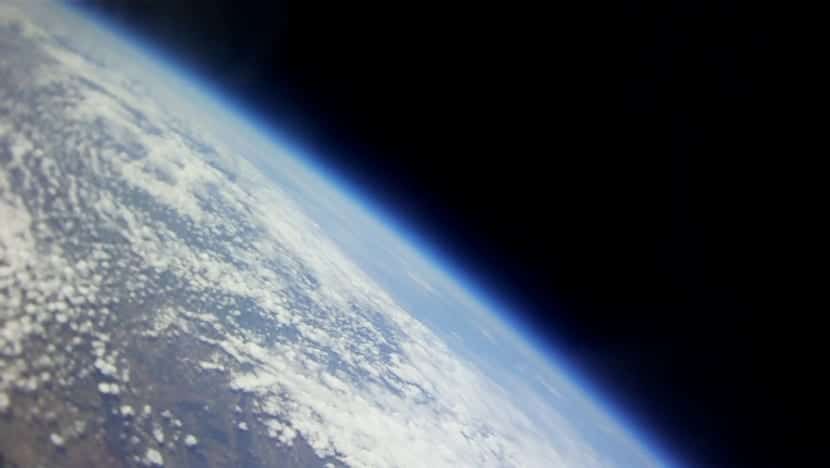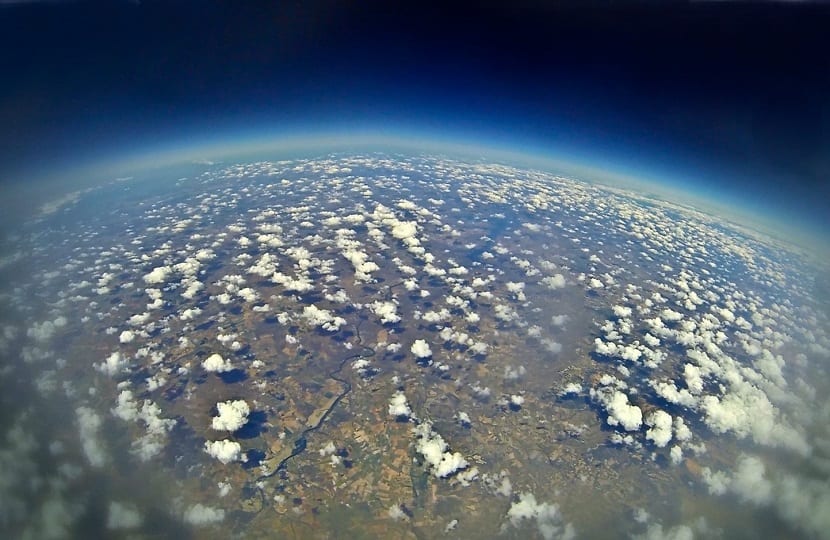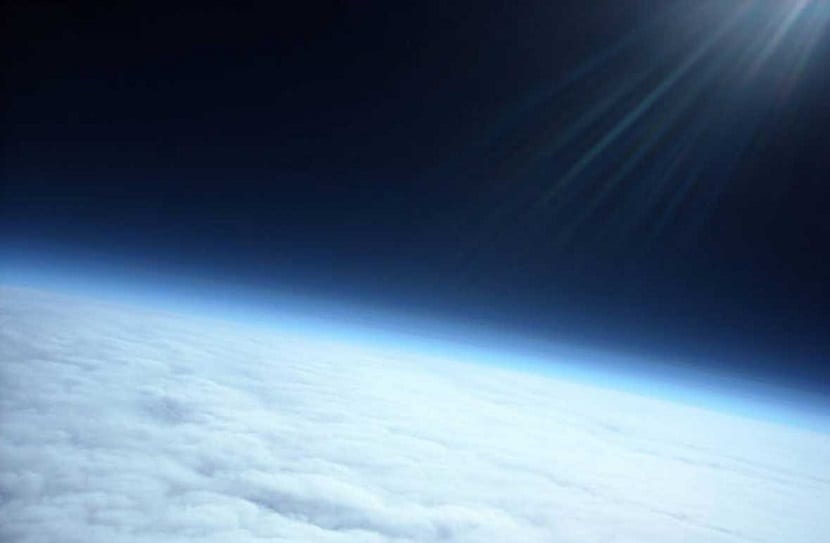
Our atmosphere has different layers in which there are different gases of different compositions. Each layer of the atmosphere has its function and its own characteristics that make it different from the rest.
We have the troposphere which is the layer of the atmosphere in which we live and in which all meteorological phenomena take place, the stratosphere which is the layer of the atmosphere in which the ozone layer is located, the mesosphere where the northern lights occur and the thermosphere that is bordering on outer space and where the temperature is very high. In this post we are going to focus on the stratosphere and the importance it has for life on our planet.
Stratosphere characteristics

The stratosphere is at a height of about 10-15 km high and extends up to about 45-50 km. The temperature in the stratosphere varies as follows: first, it begins being stable (since it is found at heights close to the tropopause where the temperature remains the same) and quite low. As we increase in altitude, the temperature of the stratosphere increases, as it absorbs more and more solar radiation. The behavior of temperature in the troposphere works the opposite of what the troposphere in which we live does, that is, instead of decreasing with height, it increases.
In the stratosphere there is hardly any vertical movement of the air, but horizontal winds can frequently reach 200 km / h. The problem with this wind is that any substance that reaches the stratosphere is diffused throughout the planet. An example of this are CFCs. These gases composed of chlorine and fluorine destroy the ozone layer and spread throughout the planet due to strong winds from the stratosphere.
There are hardly any clouds or other meteorological formations in the stratosphere. Sometimes people often confuse the increase in temperatures of the stratosphere with its proximity to the Sun. It is logical to think that the closer you are to the Sun, the hotter it will be. However, this is not the case for that. In the stratosphere we can meet the famous ozone layer. The ozone layer is not in itself a "layer", but is an area of the atmosphere in which the concentration of this gas is much higher than in the rest of the atmosphere. Ozone molecules are responsible for absorbing solar radiation that hits us directly from the Sun and allows life on Earth. These molecules that absorb the sun's ultraviolet rays transform that energy into heat and, therefore, that is why the temperature of the stratosphere increases in height.
Because there is the tropopause in which the air is very stable and there are no wind currents, the exchange of particles between the troposphere and the stratosphere is almost zero. For this reason there is hardly any water vapor in the stratosphere. This means that the clouds in the stratosphere only form if it is so cold that the small amount of existing water condenses and forms ice crystals. They are called ice crystal clouds and do not cause precipitation.
At the end of the stratosphere is the stratopause. It is an area of the atmosphere where high ozone concentrations end and the temperature becomes very stable (about 0 degrees centigrade). The stratopause is the one that gives way to the mesosphere.
As a curiosity, only chemical compounds that have a long life are those that can reach the stratosphere. Now yes, once they are there, they can stay for a long time. For example, materials emitted by large volcanic eruptions are capable of remaining in the stratosphere for almost two years.
The ozone layer

The ozone layer does not always have the same concentration of this gas far from it. In the stratosphere, the formation and continuous destruction of ozone occurs at the same time. For ozone to form, rays of sunlight must break an oxygen molecule (O2) into two oxygen atoms (O). One of these atoms when meeting another oxygen molecule reacts to form ozone (O3).
This is how ozone molecules are formed. However, naturally, just as they are created, they are destroyed by solar radiation. Light rays from the Sun strike the ozone molecule and destroy it again to give rise to an oxygen molecule (O2) and an oxygen atom (O). Now the oxygen atom reacts with another ozone molecule to form two oxygen molecules, and so on. It is a natural cycle that is in balance between the formation and destruction of ozone molecules. In this way, this layer of gases can absorb a large amount of harmful ultraviolet rays and protect us.
This has been the case for a long time. A cycle where the ozone concentration was kept at a relatively stable and constant concentration over time. However, there is another way to destroy ozone in the atmosphere. Chlorofluorocarbons (CFCs) they are very stable in the atmosphere and can therefore reach the stratosphere. These gases have a fairly long life, but when they reach the stratosphere, the ultraviolet rays from the Sun destroy the molecules, giving rise to chlorine radicals that are very reactive. These reactive radicals destroy the ozone molecules, so the amount of ozone that is destroyed in total is much larger than that generated. In this way, the balance between generation and destruction of ozone molecules capable of absorbing solar radiation that is harmful to us has been broken.
Consequences of the hole in the ozone layer
Unfortunately, in the past this topic was not known in such detail, so that in human activities (use of chlorofluorocarbon aerosols) they have managed to reach the stratosphere large amounts of chlorine and bromine that destroy ozone molecules. Because the reaction requires light and the formation of polar clouds at very low temperatures, the lowest levels of ozone occur in the spring of Antarctica and the ozone hole forms especially over Antarctica. These ozone holes cause more ultraviolet radiation to reach the Earth's surface and accelerate the thaw.
In humans, the degradation of the ozone layer has caused an increase in the incidence of skin cancer due to a greater amount of solar radiation that reaches us. Plants are also affected, especially those that are growing and have weaker and less developed stems and leaves.
Impacts of airplanes in the stratosphere

Airplanes have also had an impact on the stratosphere, because they usually fly at a height of between 10 and 12 km, that is, close to the tropopause and the beginning of the stratosphere. As air traffic has grown, emissions of carbon dioxide (CO2), water vapor (H2O), nitrogen oxides (NOx), sulfur oxides (SOx) and soot have increased to the atmosphere between the upper troposphere and the lower stratosphere.
Nowadays, airplanes only cause between 2 and 3% of global greenhouse emissions. This is not of great importance in terms of global warming either. However, what is really important about airplanes is that the gases they emit do so in the upper part of the troposphere. This causes the emitted water vapor to increase the chances of forming cirrus clouds that retain more heat on Earth and contribute to global warming.
On the other hand, nitrogen oxides emitted by airplanes are also dangerous, since they are related to the disappearance of ozone in the stratosphere. We have to think that although the greenhouse gases emitted by airplanes do not have a very long life to reach the stratosphere, they can do so, because they are being released at a height very close to it.
Stratosphere curiosities

This layer of the atmosphere has some curiosities that may surprise us. Among those curiosities are:
- Air density is 10% lower that on the earth's surface
- Temperatures in the lower layers are around -56 degrees on average and air currents reach 200 kilometers per hour.
- There are reports that ensure the existence of small microorganisms living in the stratosphere. These microbes are believed to have come from space. They are bacterial spores, extremely resistant organisms that can form a protective layer around themselves and therefore survive the low temperatures, dry conditions and high levels of radiation found in the stratosphere.
As you can see, the atmosphere has great functions for us and the rest of the living beings that inhabit our planet. The stratosphere contains something that is necessary for our survival and that, although it is kilometers high, we must protect.